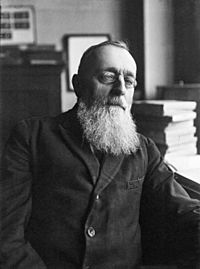Alfred Lacroix facts for kids
Quick facts for kids
Antoine Lacroix
|
|
|---|---|

Antoine Lacroix (1924)
|
|
| Born | 4 February 1863 |
| Died | 12 March 1948 (aged 85) |
| Nationality | French |
| Awards | Wollaston Medal (1917) Hayden Memorial Geological Award (1923) Penrose Medal (1930) Fellow of the Royal Society |
| Scientific career | |
| Fields | mineralogist and geologist |
| Doctoral advisor | Ferdinand André Fouqué |
Antoine François Alfred Lacroix (February 4, 1863 – March 12, 1948) was a famous French scientist. He was a mineralogist (someone who studies minerals) and a geologist (someone who studies Earth's rocks and history). He was born in Mâcon, France.
Contents
Studying Science
Antoine Lacroix studied science in Paris, the capital city of France. He earned his science degree in 1889. His teacher was Ferdinand André Fouqué, who was also a very important scientist.
A Busy Career
In 1893, Lacroix became a professor of mineralogy. He taught about minerals at the Jardin des Plantes in Paris. A few years later, in 1896, he became the director of the mineralogy lab at the École des Hautes Études.
Studying Volcanoes and Rocks
Lacroix was very interested in minerals found near volcanoes. He also studied igneous rocks, which are formed from cooled lava or magma. He looked at how rocks change over time, a process called metamorphism. He also studied mineral veins, which are thin layers of minerals found in rocks.
He traveled to many parts of the world for his studies. He explored the Pyrenees mountains and the island of Madagascar.
Important Discoveries
One of his most famous works was about the eruptions in Martinique. This book, called La Montagne Pelée et ses éruptions, was published in 1904. It was a very detailed study of the volcano's behavior.
He also wrote a major book about the minerals of France. It was called Minéralogie de la France et de ses Colonies. He worked with another scientist, Auguste Michel-Lévy, on other important projects.
Leading Science Groups
Antoine Lacroix was a leader in the scientific community. From 1922 to 1927, he was the president of the volcanology section of the International Union of Geodesy and Geophysics (IUGG). This is a big international group that studies Earth. In 1904, he became a member of the Académie des sciences, a famous French science academy.
He received several important awards for his work. These included the Wollaston Medal in 1917 and the Penrose Medal in 1930.
His Legacy
Antoine Lacroix's work left a lasting mark on science.
Things Named After Him
- A type of Asian snake, Oligodon lacroixi, is named in his honor.
- A glacier in Antarctica, called the Lacroix Glacier, also carries his name.
His Modesty
Lacroix was a very humble person. He wanted his burial to be simple, with only his family present. He believed that what mattered most was being remembered for his work and contributions to science, not for big ceremonies.
Helping Museums
Antoine Lacroix was one of the people who helped start the Society of Friends of André-Marie Ampère in 1930. This group worked to create the first science museum in France, the Ampère Museum, near Lyons.

